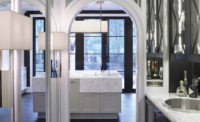When a tile contractor approaches a new construction project to install a traditional tile shower floor, he is likely to face some considerable prep time. This often includes cutting back the existing sheet rock, which has been run to the floor, and installing solid "blocking" between the studs. Before the membrane can be installed, the floor must be "pre-sloped" (1/4 inch per foot) to the weep holes of the sub-drain assembly. After the pre-slope is cured, the contractor can install the pan liner. Once the pan liner has been installed, he must check that the shower pan has not been damaged or that nails or screws have not been driven through it, as is sometimes the case. The next step is to float a primary mortar bed on top of the liner, making sure to first surround the weep holes of the sub-drain with crushed tile or stone. [Note: Smart contractors will install a drainage mat on top of the pan liner before floating the primary mortar bed so that water can freely run off the pan liner and into the weep holes. Using a drainage mat eliminates the need for placing crushed tile or stone around the weep holes.] The contractor will then lay the tile, making difficult cuts around a round drain grate.
Although this system will perform when installed correctly, it has some obvious drawbacks. For one, it is extremely labor intensive. The multiple steps involved result in labor days instead of what could be labor hours. Additionally, when water migrates through the grout joints of the tile floor and into the mortar bed, saturation of the mortar bed can occur, especially if no drainage mat is used. A saturated mortar bed leads to the harboring of fungus and bacteria, and, eventually, deterioration of the mortar bed itself. The common sense question here is, "Why allow saturation of the mortar bed in the first place?"
The inception of load-bearing, bondable waterproof membranes for thin-set stone installations allowed installers to place the waterproofing on top of the mortar bed instead of below it. However, a new drain system was needed to accommodate such a membrane. This drain system would now have to allow a secure, watertight connection between the bonded waterproof membrane and the top of the drain assembly rather than below it. Schl¿ter-Kerdi-Drain has an integrated bonding flange that successfully allows a watertight connection to bondable membranes at the surface of the drain assembly. By achieving a 100% watertight connection to the drain on the surface, no sub-drain assembly is needed. The two-step mortar pan (pre-slope and primary) now becomes a single-step system, because no pre-slope to the sub-drain is required. Nearly all of the prep work required with the old system is eliminated, since there is no water penetration or saturation of the mortar bed. Consequently, what used to take days now takes hours, with superior results.
This innovation in floor drain technology will be reflected in the 2001 TCA Handbook, method B421-01. Schl¿ter-Systems packages Kerdi-Drain with all the necessary accessories. The grate is high-grade stainless steel and is 4 inches square to better accommodate grout joint and tile patterns. Below the grate is a debris strainer that can be easily removed and cleaned. A height-adjustment collar that adjusts to accommodate tile thicknesses of 1/4 inch to 1 1/4 inch holds the grate in place. A lateral adjustment ring, which accommodates grout joint and tile patterns, holds these components in place. The fleeced bonding flange facilitates bonding to the adjoining membrane on the mortar bed surface. The package also includes a Schl¿ter-Kerdi-Collar (39 x 39 inches, with a pre-cut hole for ease of installation) and Kerdi-Kereck inside and outside corner joiners for addressing the shower curb connections. This package, in conjunction with Schl¿ter-Kerdi membrane (ANSI 118.10) and latex-modified thinset, is all that is needed for a completely waterproof shower installation.
